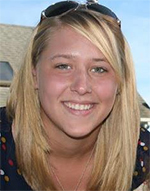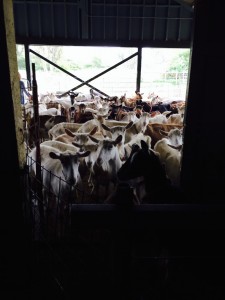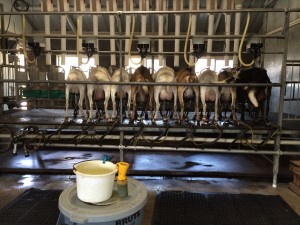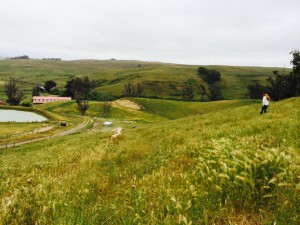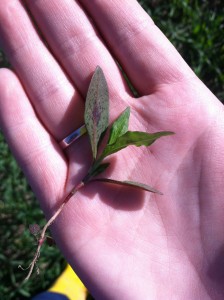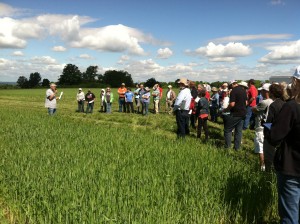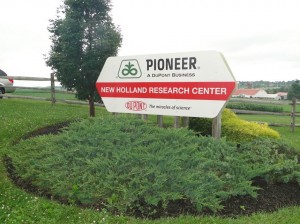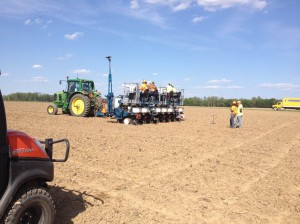 I made it through my first week, learning a lot on the way. The biggest thing I am starting to figure out, is that I need to be prepared for anything I might be doing on any given day. I especially got this on Thursday. I woke up Thursday morning looking at a rainy forecast, knowing I had a substantial amount of office work to do from recording the invasive species on the perimeter of the 4-H Training Center from the previous day, and I knew there was a conference call I would be sitting in on in the afternoon. So I decided to look nice and dress for the office and threw my boots in the car just in case we went out to a farm or something.
I made it through my first week, learning a lot on the way. The biggest thing I am starting to figure out, is that I need to be prepared for anything I might be doing on any given day. I especially got this on Thursday. I woke up Thursday morning looking at a rainy forecast, knowing I had a substantial amount of office work to do from recording the invasive species on the perimeter of the 4-H Training Center from the previous day, and I knew there was a conference call I would be sitting in on in the afternoon. So I decided to look nice and dress for the office and threw my boots in the car just in case we went out to a farm or something.
Well, John (a fellow intern), Laurel, and I did end up in the field for part of the early afternoon. One of the mapping technologies we are using to record invasive species we find is a program called iMap Invasives, and there was an entry from the National Grid of Mile-A-Minute vine along some power lines not too far from us. Because this could be the first sighting of this vine in the county, we decided to head out just to make sure, because if it turns up, it is going to be a major one we are going to need to keep an eye on.
We made it out to the first location with the recorded coordinates and there showed no sign of the vine. We then walked another ~half mile or so to the second location. Along the way we noticed that the ground these power lines run across is not actually dry land, but very wetlands. I was in my boots, fortunately. However, my pants, my only nice pair of khakis, were not so lucky at times where the water got fairly deep. The pants ended up with some black mud on the bottom of them but I trudged along though because I am not going to allow my unpreparedness in the field to get in the way of my job. After all of this though, we made it to the second location, and there was also still no sign of Mile-a-Minute and I learned that maybe just my boots is not the only change of attire I am going to be needing this summer.
Saturday I went out to the 4-H training center again, where I assisted John and his project in the morning. John, in collaboration with CCE and the New York Forest Owners Association (NYFOA), have decided to create a deer exclosure to monitor deer damage in the forest. This information will also be useful for homeowners to see how easy it is to get the materials needed to install a fence to prevent losses in their own gardens.
The deer exclosure is a 1000 ft. enclosed area with an 8 ft. high fence with posts made of both rebar and 2×2 boards. The control is an area of equal size marked adjacent to it. The observation will take place over a few years to show that deer have a major impact on tree sapling growth on the forest floor.
The past few days I have also been working on a brochure – Gardening Native Plants-for alternative native species of plants that homeowners can plant instead of/ or in replacement of popular invasive plant species in their gardens or landscapes. Some of these invasives include Burning Bush, Japanese Honeysuckle, Japanese Barberry, or Oriental Bittersweet. I spent some time making a public handout that would help people recognize these invasives and give them an idea of what would be a similar alternative that is just as beautiful and has less of a lasting impact on the environment and economy. (Click the link above to see what you may have in your garden).
Last thing I want to discuss is my project descriptions. Yes, plural. They are definitely keeping me very busy here.
Project 1: The Main
So far what I gathered is that I will be mapping invasive plant species encroachment on agricultural fields around Saratoga County and some of the surrounding counties that lie in the Capital/Mohawk PRISM (Partnership for Regional Invasive Species Management). The state is broken in to 8 of these PRISMS – the Capital/Mohawk, Lower Hudson, Long Island, Catskills, Adirondacks, St. Lawrence, Finger Lakes, and Western NY. My work will focus in this PRISM, while similar observations will be taken in the Finger Lakes PRISM by a colleague/classmate for the same purpose. All of it will be analyzed by Toni DiTomasso, a weed science professional at Cornell, and released to the PRISMs from which the data was collected. All invasive information will be entered into the iMap Invasive program.
Project 2: Inventory
A thing I have been asked to keep a look out for and inventory their locations and densities, is Common Milkweed. As many may know, the Common Milkweed is a major weed in many agricultural fields but at the same time, a major vector for agricultural pollinators. The Monarch Butterfly, a near threatened species, lays their eggs on milkweed, and with the dying population of milkweed due to herbicides in many fields, the butterfly population is also dwindling. I will be noting the milkweed locations and entering them into a project separate from my invasive species in iMap Invasives.
Project 3: Invasives in Hay
Starting tomorrow, John and I will be shaking out hay bales for seeds that may be from invasive species. We will germinate any seeds we find to determine what species it is and not only if it is a pest to farmers, but is it harmful to horses as well. We have samples from out of state hay farms as well as a local control to see what we could potentially be bringing into the area that does not belong here. Saratoga is a largely populated area for horses and not all horse farmers grow their own, so many will buy it in from other areas. Is what gets brought in harmful to horses in any way? And will it be adding to the large inventory of invasive species to the area?

